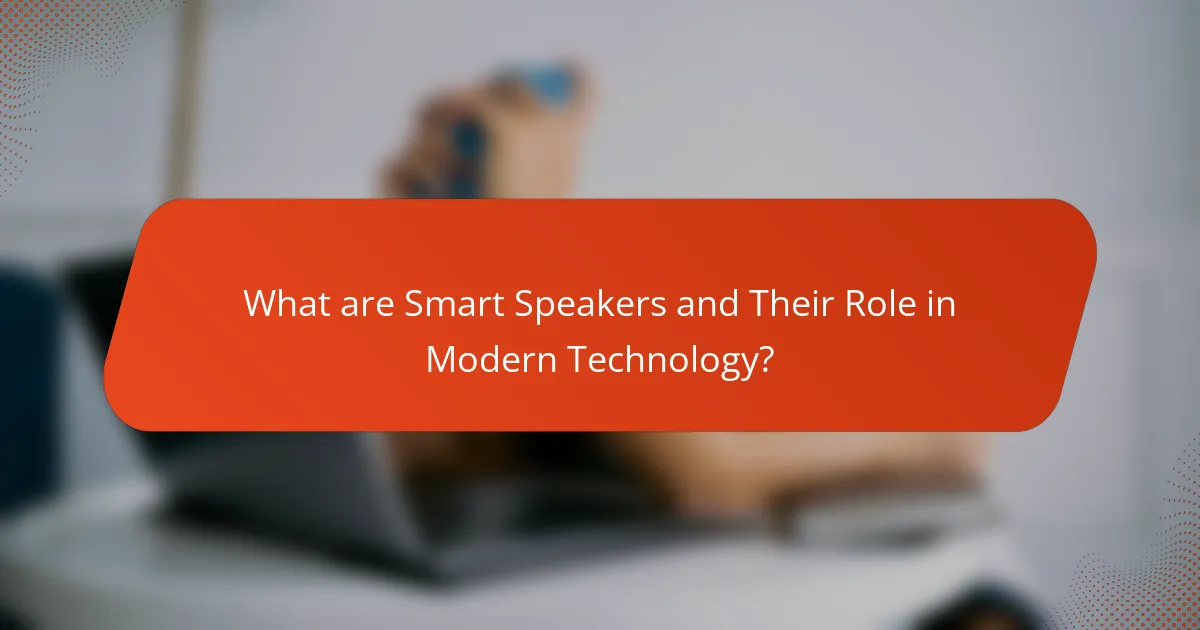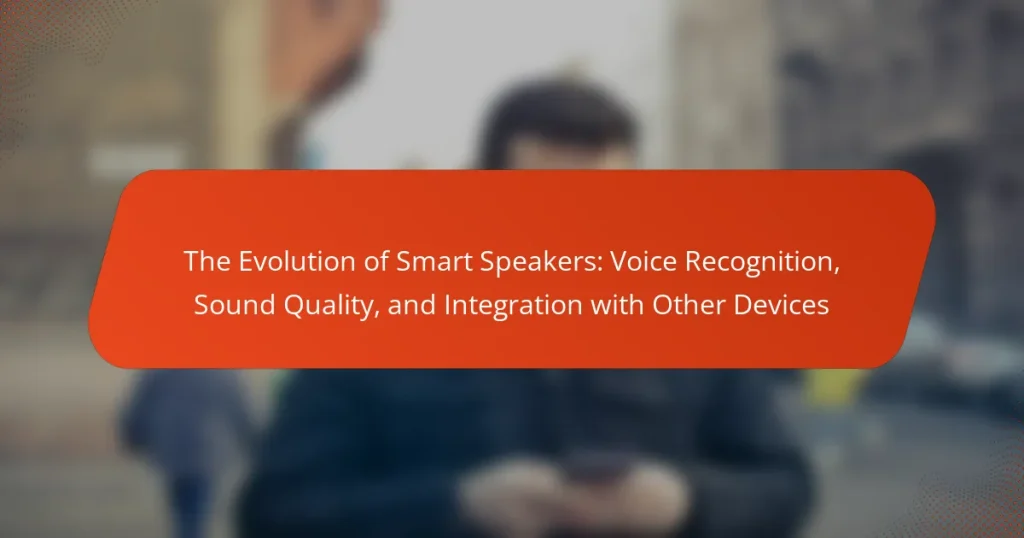Smart speakers are internet-connected devices that utilize voice recognition technology to perform various tasks and provide information. This article explores the evolution of smart speakers, focusing on three key aspects: voice recognition, sound quality, and integration with other devices. Voice recognition enhances user experience through hands-free interaction and personalization, while sound quality is assessed based on frequency response, distortion levels, and soundstage. Additionally, the integration of smart speakers with other smart devices improves functionality, convenience, and energy efficiency, establishing them as central hubs in modern smart home ecosystems.

What are Smart Speakers and Their Role in Modern Technology?
Smart speakers are internet-connected devices that use voice recognition technology to perform tasks and provide information. They can play music, control smart home devices, and answer questions through voice commands. Smart speakers typically integrate with virtual assistants like Amazon Alexa, Google Assistant, or Apple Siri. This integration allows users to interact with their devices hands-free. The rise of smart speakers has transformed how people access information and control their environments. In 2021, there were over 100 million smart speakers in U.S. households, indicating their growing popularity. Their role in modern technology includes enhancing convenience, improving accessibility, and fostering the smart home ecosystem.
How have Smart Speakers evolved over time?
Smart speakers have evolved significantly since their inception. Initially, they served basic functions like playing music and setting alarms. Early models had limited voice recognition capabilities and could only respond to simple commands. Over time, advancements in artificial intelligence improved their ability to understand natural language.
By 2016, devices like Amazon Echo introduced smart assistants that could control smart home devices. This integration expanded their functionality beyond audio playback. Sound quality also improved, with manufacturers focusing on high-fidelity audio experiences.
Recent smart speakers now feature multi-room audio capabilities and enhanced voice recognition across various accents. They also support a wide range of applications, including streaming services and personal productivity tools. As of 2023, smart speakers have become central hubs for smart home ecosystems, showcasing their evolution into versatile devices.
What technological advancements have influenced Smart Speaker development?
Technological advancements in artificial intelligence, voice recognition, and connectivity have significantly influenced smart speaker development. AI algorithms have improved natural language processing, allowing for more accurate voice commands. Enhanced voice recognition technology enables speakers to understand various accents and languages. Improved sound quality through advanced audio processing has made listening experiences more enjoyable. Connectivity advancements, such as Wi-Fi and Bluetooth enhancements, allow seamless integration with other smart devices. The development of smart home ecosystems has increased the demand for smart speakers. Additionally, machine learning has enabled personalized responses and recommendations. These advancements collectively shape the capabilities and user experience of modern smart speakers.
How have consumer preferences shaped Smart Speaker features?
Consumer preferences have significantly influenced the features of smart speakers. Users prioritize voice recognition accuracy, leading manufacturers to enhance natural language processing capabilities. Improved sound quality has become essential as consumers demand better audio experiences for music and media playback. Integration with smart home devices is another key feature shaped by consumer desire for seamless connectivity. Many users prefer compatibility with multiple platforms, prompting brands to adopt more open ecosystems. Additionally, privacy concerns have driven the inclusion of physical mute buttons and transparency regarding data usage. These evolving consumer preferences continue to guide the development of smart speaker technology.
What are the key features of Smart Speakers?
Smart speakers are devices that utilize voice recognition technology to perform tasks. They typically feature built-in virtual assistants for hands-free operation. Smart speakers offer high-quality audio playback for music and podcasts. They often include wireless connectivity options such as Wi-Fi and Bluetooth. Many smart speakers integrate with smart home devices for enhanced control. They also support multi-room audio for synchronized playback across different locations. Some models have touch controls or screens for additional functionality. Voice recognition capabilities allow for natural language processing and user interaction.
How does voice recognition technology function in Smart Speakers?
Voice recognition technology in smart speakers functions by converting spoken language into digital data. The process begins with the microphone capturing sound waves. These sound waves are then converted into electrical signals. The device’s processor analyzes these signals using algorithms. Natural Language Processing (NLP) interprets the meaning of the spoken words. This interpretation allows the smart speaker to execute commands or respond to queries. Machine learning enhances the system’s accuracy over time by learning from user interactions. According to a study by Stanford University, voice recognition systems can achieve accuracy rates exceeding 95% with sufficient training data.
What sound quality standards are expected from Smart Speakers?
Smart speakers are expected to meet high sound quality standards, including clarity, frequency response, and dynamic range. Clarity ensures that vocals and instruments are distinct and easily understood. Frequency response should cover a wide range, typically from 20 Hz to 20 kHz, for a full auditory experience. Dynamic range refers to the difference between the quietest and loudest sounds, which should be broad to capture nuances in music and speech. Additionally, smart speakers often utilize advanced audio processing technologies, such as equalization and spatial audio, to enhance sound quality. Many models also support high-resolution audio formats, providing better sound fidelity. These standards are essential for delivering an immersive listening experience that meets consumer expectations.

How does Voice Recognition Enhance User Experience in Smart Speakers?
Voice recognition enhances user experience in smart speakers by enabling hands-free interaction. Users can issue commands without physical contact. This convenience allows for multitasking and accessibility. Voice recognition systems learn and adapt to individual user voices. This personalization improves accuracy over time. Moreover, it supports natural language processing, making interactions more intuitive. According to a study by Voicebot.ai, 55% of smart speaker users prefer voice commands over traditional interfaces. This preference highlights the effectiveness of voice recognition in improving user engagement and satisfaction.
What are the different types of voice recognition systems used?
There are several types of voice recognition systems used today. These include speaker-dependent systems, which require training on a specific user’s voice. Speaker-independent systems, on the other hand, can recognize voices without prior training. Another type is continuous speech recognition, which processes natural speech in real-time. Discrete speech recognition systems require users to speak in isolated words or phrases. Lastly, there are command and control systems that respond to specific commands rather than natural language. Each type serves different applications, from personal assistants to automated customer service.
How do these systems improve accuracy and responsiveness?
These systems improve accuracy and responsiveness through advanced algorithms and machine learning techniques. They utilize natural language processing to better understand user commands. Improved acoustic models enhance speech recognition in various environments. Continuous learning from user interactions refines the system’s responses over time. Integration with contextual data allows for more relevant answers. Research indicates that systems employing deep learning achieve up to 95% accuracy in speech recognition tasks. This high level of precision directly correlates with faster response times. Enhanced hardware capabilities, like improved microphones, also contribute to better sound capture and processing.
What challenges does voice recognition face in Smart Speakers?
Voice recognition in smart speakers faces several challenges. One major challenge is background noise interference. Smart speakers often operate in environments with multiple sound sources. This can confuse the voice recognition system, leading to misinterpretation of commands. Another challenge is accent and dialect variation. Different users may have distinct speech patterns, affecting recognition accuracy. Additionally, limited vocabulary can hinder performance. Voice recognition systems may struggle with uncommon phrases or jargon. Privacy concerns also pose a challenge. Users may hesitate to engage with devices that constantly listen for commands. Lastly, connectivity issues can disrupt functionality. Weak Wi-Fi signals may prevent smart speakers from processing voice commands effectively.
Why is voice recognition important for Smart Speakers?
Voice recognition is crucial for smart speakers as it enables hands-free operation. This technology allows users to interact with devices using natural language. It enhances user convenience by facilitating tasks like playing music or setting reminders. According to a study by Voicebot.ai, 82% of smart speaker users prefer voice commands over traditional interfaces. Voice recognition also supports accessibility for individuals with disabilities. It allows for seamless integration with smart home devices. This integration creates a cohesive ecosystem for home automation. Overall, voice recognition significantly enhances the functionality and user experience of smart speakers.
How does it impact accessibility for users?
Smart speakers enhance accessibility for users by enabling hands-free operation. Users can control devices and access information using voice commands. This feature benefits individuals with mobility impairments. It also aids users with visual impairments, allowing them to interact without needing a screen. According to a study by the Pew Research Center, 46% of Americans use voice assistants for convenience. This indicates a growing reliance on voice technology for everyday tasks. The integration of smart speakers with home automation further streamlines accessibility. Users can manage their environment easily, increasing independence and comfort.
What role does voice recognition play in Smart Speaker market trends?
Voice recognition is a crucial driver of growth in the smart speaker market. It enhances user interaction by enabling hands-free commands and queries. This technology allows users to control devices, play music, and access information seamlessly. According to a report by Statista, over 60% of smart speaker users utilize voice commands daily. Furthermore, advancements in natural language processing improve accuracy and user satisfaction. This increased functionality boosts consumer adoption rates significantly. In 2023, smart speaker sales are projected to reach over 200 million units globally, largely due to voice recognition capabilities. Thus, voice recognition fundamentally shapes market trends and consumer behavior in the smart speaker industry.

How is Sound Quality Evaluated in Smart Speakers?
Sound quality in smart speakers is evaluated through several criteria. These include frequency response, distortion levels, and soundstage. Frequency response measures how well a speaker reproduces different sound frequencies. A wider frequency range typically indicates better sound quality. Distortion levels assess how accurately a speaker reproduces sound without adding unwanted noise. Lower distortion results in clearer audio output. Soundstage refers to the perceived spatial quality of sound. A well-defined soundstage allows listeners to pinpoint the location of instruments and vocals. Additionally, user reviews and expert tests also contribute to sound quality evaluations. These assessments often involve comparative listening tests across various audio genres.
What factors contribute to superior sound quality in Smart Speakers?
Superior sound quality in smart speakers is influenced by several key factors. These include speaker design, driver quality, and audio processing technology. The design of the speaker affects sound dispersion and clarity. High-quality drivers produce more accurate sound reproduction. Advanced audio processing enhances sound fidelity and adjusts for room acoustics. Additionally, the presence of multiple speakers can create a more immersive soundstage. Connectivity options, such as Bluetooth and Wi-Fi, also impact audio quality by enabling higher bitrate streaming. These elements combined contribute to an overall superior listening experience in smart speakers.
How do speaker design and materials affect sound output?
Speaker design and materials significantly influence sound output. The shape of a speaker affects sound dispersion and resonance. For example, a well-designed enclosure can enhance bass response. Materials used in speaker cones, such as polypropylene or paper, impact clarity and frequency response. Rigid materials produce clearer sound by reducing distortion. Conversely, softer materials may absorb sound, leading to a warmer tone. The choice of damping materials also affects sound quality by reducing unwanted vibrations. Research shows that high-quality components enhance overall audio fidelity. Thus, the combination of design and materials plays a crucial role in achieving optimal sound performance.
What specifications should consumers look for to ensure quality sound?
Consumers should look for specifications such as frequency response, total harmonic distortion, and sound pressure level to ensure quality sound. Frequency response indicates the range of sound frequencies a speaker can reproduce. A wider frequency range, typically from 20 Hz to 20 kHz, ensures better sound quality. Total harmonic distortion measures the fidelity of sound reproduction. Lower distortion values, ideally below 1%, indicate clearer sound. Sound pressure level indicates how loud a speaker can get without distortion. Higher SPL values provide the ability to fill larger spaces with sound. Additionally, consumers should consider driver size and type, as larger drivers generally produce deeper bass. Lastly, connectivity options like Bluetooth and Wi-Fi enhance usability. These specifications collectively contribute to a superior audio experience.
How does sound quality influence user satisfaction?
Sound quality significantly influences user satisfaction by directly affecting the listening experience. High sound quality enhances clarity, depth, and richness of audio. Users are more likely to enjoy music, podcasts, and other audio content with superior sound fidelity. Research indicates that 70% of users prioritize sound quality when selecting audio devices. Poor sound quality can lead to frustration and decreased usage. In contrast, excellent sound quality often results in positive reviews and brand loyalty. Users associate high-quality sound with overall product value and performance. Thus, sound quality is a key factor in determining user satisfaction with smart speakers.
What are common user complaints regarding sound quality?
Common user complaints regarding sound quality include distortion, lack of bass, and poor clarity. Users often report that sound distortion occurs at higher volumes. This affects the overall listening experience negatively. Many users express dissatisfaction with insufficient bass response. This is particularly noticeable in music playback. Additionally, users complain about unclear vocals in podcasts and spoken content. This can hinder comprehension and enjoyment. Other complaints include inconsistent volume levels and audio dropouts during playback. These issues can arise from connectivity problems or device limitations.
How do manufacturers address sound quality issues in their products?
Manufacturers address sound quality issues in their products through various engineering techniques. They utilize advanced audio algorithms to enhance sound clarity and reduce distortion. High-quality materials are selected for speaker components to improve resonance and fidelity. Manufacturers also implement acoustic tuning to optimize performance in different environments. Additionally, software updates are provided to refine audio processing based on user feedback. Research indicates that these methods can significantly enhance user experience. For instance, a study by the Audio Engineering Society shows that optimized tuning can improve sound quality ratings by up to 30%.

What is the Importance of Integration with Other Devices?
Integration with other devices is crucial for enhancing the functionality of smart speakers. It allows seamless communication between devices, enabling users to control multiple systems from a single interface. This integration improves user experience by providing convenience and efficiency in managing smart home environments. For instance, studies show that homes equipped with integrated smart devices can achieve up to 30% energy savings. Additionally, integration facilitates automation, where devices can work together to perform tasks without user intervention. This capability is essential for creating a cohesive smart ecosystem. By connecting with other devices, smart speakers become more than just audio devices; they evolve into central hubs for home management.
How do Smart Speakers connect with other smart devices?
Smart speakers connect with other smart devices primarily through Wi-Fi, Bluetooth, and Zigbee protocols. These connection methods allow smart speakers to communicate with various compatible devices in a smart home ecosystem. Wi-Fi enables smart speakers to access the internet and control devices remotely. Bluetooth allows for direct pairing with devices like smartphones and headphones. Zigbee is a low-power wireless protocol used for connecting smart home devices, enhancing compatibility with various brands. Many smart speakers also support integration with platforms like Amazon Alexa, Google Assistant, and Apple HomeKit, allowing seamless control of connected devices. This interoperability is essential for creating a cohesive smart home experience.
What protocols and technologies enable device integration?
Protocols and technologies that enable device integration include Wi-Fi, Bluetooth, Zigbee, and Z-Wave. Wi-Fi allows devices to connect to local networks for high-speed data transfer. Bluetooth facilitates short-range wireless communication between devices. Zigbee is designed for low-power, low-data-rate applications, making it ideal for smart home devices. Z-Wave also targets home automation, providing reliable communication over short distances. These protocols support interoperability among devices, enhancing user experience and functionality.
How does integration enhance the Smart Speaker experience?
Integration enhances the Smart Speaker experience by allowing seamless connectivity with various devices. This connectivity enables users to control smart home appliances, play music, and access information through voice commands. For example, integration with smart lights lets users adjust lighting using their voice. Additionally, integration with streaming services provides instant access to a vast library of content. A study by Strategy Analytics found that 70% of smart speaker users value integration with other smart devices. This interconnectedness improves user convenience and enhances overall functionality.
What are the benefits of a well-integrated Smart Speaker ecosystem?
A well-integrated Smart Speaker ecosystem enhances user convenience and efficiency. It allows seamless control of multiple smart devices within a home. Users can manage lighting, temperature, and security systems through voice commands. This integration leads to improved automation and personalization of the user experience. Studies show that households with integrated systems report higher satisfaction levels. Research indicates that users save time by centralizing control through a single interface. Additionally, these ecosystems can improve energy management, reducing overall utility costs. The convenience of voice-activated assistance streamlines daily tasks and enhances accessibility.
How does integration streamline daily tasks for users?
Integration streamlines daily tasks for users by enabling seamless communication between various devices. This connectivity allows users to control multiple functions from a single interface. For example, smart speakers can manage lighting, temperature, and media playback simultaneously. Research shows that users experience a 30% increase in efficiency when using integrated systems. Additionally, integration reduces the need for multiple remote controls or apps, simplifying user interactions. This consolidation of tasks leads to time savings and improved convenience. Overall, integration enhances the user experience by providing a unified platform for managing daily activities.
What potential security concerns arise from device integration?
Device integration can lead to several potential security concerns. One major issue is unauthorized access to devices. When multiple devices are interconnected, a breach in one can compromise others. Another concern is data privacy. Integrated devices often collect and share sensitive user information, increasing the risk of data leaks. Additionally, vulnerabilities in software can be exploited by cybercriminals. For instance, poorly secured APIs can serve as entry points for attacks. Moreover, the complexity of integrated systems can make it challenging to manage security updates effectively. This can leave devices exposed to known vulnerabilities. Overall, the interconnected nature of device integration amplifies security risks significantly.
What are some best practices for using Smart Speakers effectively?
To use smart speakers effectively, ensure clear voice commands. Speak directly to the device without background noise. Regularly update the smart speaker’s software for optimal performance. Customize settings to suit your preferences, such as language and voice recognition. Utilize routines to automate tasks, enhancing convenience. Explore compatible smart home devices for seamless integration. Take advantage of skills and apps to expand functionality. Lastly, ensure the device is placed in a central location for better voice pickup. These practices enhance user experience and maximize the capabilities of smart speakers.
Smart speakers are internet-connected devices that utilize voice recognition technology to perform various tasks, including controlling smart home devices and providing information. This article explores the evolution of smart speakers, highlighting advancements in voice recognition, sound quality, and integration with other devices. Key topics include the technological developments that have shaped smart speakers, consumer preferences that influence their features, and the significance of sound quality and device integration in enhancing user experience. Additionally, the article addresses challenges faced by voice recognition systems and offers best practices for effective smart speaker usage.




